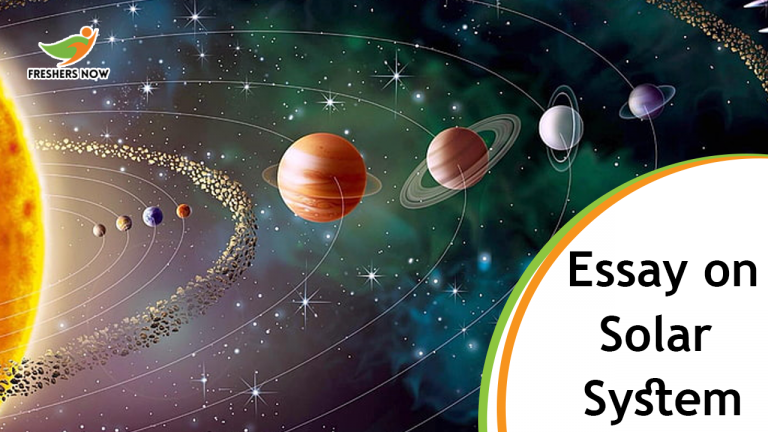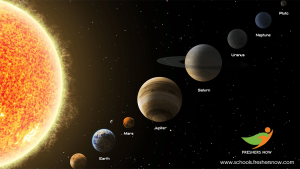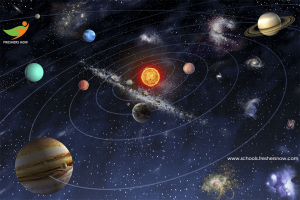
In this article, we are providing an essay on Solar System. Life in a Village, Advantages, Disadvantages, Images. Students can go through this page for more information on the Solar system.
Contents
Long Essay On Solar System for Students and Children
Solar System – It is the system of planets along with the sun, that is seized by its magnetism and gyrate around. The solar system consists of eight planets that swivel around the sun, which is the hub of our solar system.
These eight planets are of two types, they are the internal planets and the external planets.
Internal planets are Mercury, Venus, Earth, and Mars.
External planets are Uranus, Jupiter, Saturn, and Neptune.
Pluto was also a planet earlier, but now it is considered a dwarf planet.
The internal planets are the planets that are nearer to the sun and they are slighter in size. The external planets are immense. The internal planets are endorsed as Terrestrial planets. The external planets are endorsed as Giant planets. The solar system also consists of moons, comets, asteroids, satellites, dust, and gas. “When you look at the stars and the galaxy, you feel that you are not just from any particular piece of land but the Solar System”.
Formation of our Solar System
Based on many debates, below is the delineate of the existing information.
Birth of the Sun
- Approximately, five billion years ago, a colossal cloud floated in one of the spiral arms of the Milky way of the galaxy.
- This cloud is called a nebula, which is through dust and gas.
- As the encounter of disturbance, the nebula began to move.
- Due to the progress, the cloud started to crumble on itself by its gravity.
- As the process of collusion extended, the temperature of the cloud increased. The rotation became enormous.
- Due to the high temperature spawned by the rotation, the cloud instigates to squash out into a disk contour with the bulk of mass positioned at its center.
- Nuclear fusion took the track at a point, where enormous temperature and pressure built on the cloud.
- Then the star was born – and that is our Sun.
Birth of the Planets
- After the birth of the Sun, the dust and the gas in the Milky Way Galaxy started to unruffle and be reduced into tiny particles.
- The particles amplified in mammoth quantity, they started to bump with each other and trapped together. As a result, rocks and boulders were created by the particles themselves.
- The hefty bodies put up are referred to as Planetesimals.
- Planetary embryos were formed due to the gathering of the planetesimals. These embryos were very massive to exert the gravitational force on surrounding objects. So the collisions amid them were not possible, instead, they pulled objects in the surrounding area to themselves.
- The material in the area was acquired by the planetary embryo, the PLANETS came into existence.
- The other bits and pieces did not unite the Sun nor Planets reduced to form the moon, asteroids, or comets.
- Over the period, the orbits of the planets and other bodies stabilized into the solar system that we are aware of today.
The uniqueness of the Planets in the Solar System
- Sun – The sun is the prevalent star present at the midpoint of the solar system. The sun is the self-luminous sphere of gas. Sun embraces the intact solar system due to its gravitational force. The radius of the sun is 696,340 kilometers. Distance from the earth is 150 million kilometers.
- Mercury – It is the nominal planet in the solar system, which is the nearest planet to the Sun. One revolution of this planet completes in 88 earth days, as the reason, it is referred to as Swift Planet. Mercury consists of lobed crest and impact craters. As it is the closest planet next to the sun, the temperature can go high to 450 degrees Celsius. Astonishingly nights are cold. The radius of mercury is 2,439.7 kilometers.
- Venus – Venus is the second planet close to the sun. Venus is the brightest planet, so it is called the morning star. One revolution of Venus around the sun completes in 255 earth days. The planet is visible to the naked eyes. Venus is the hottest planet, due to the toxic atmosphere it traps heat regularly. The radius of Venus is 6,051.8 kilometers.
- Earth – Earth is the third planet in the solar system. It is the leading inner planet. It is the only planet where existence is doable. One revolution of the earth around the sun completes in 365 days. It is called the blue planet, as one-third of the earth is surrounded by water. Moon is a natural satellite on earth. The radius of the earth is 6,371 kilometers.
- Mars – Mars is the fourth planet in the solar system. It is called the Red planet, due to the presence of iron oxide. The geographical features are quite similar to the planet earth. One revolution of mars around the sun completes in 687 earth days. It is the coldest planet. It’s expected to be the second home for human beings after earth.
The radius of mars is 3,389.5 kilometers. - Jupiter – Jupiter is the largest in the solar system. It is called a Gas Giant planet. The planet is rich in hydrogen and helium gases. One revolution of Jupiter around the sun completes in 4333 earth days. It has 79 satellites. Jupiter has Great red spots and color
bands surrounding the planet. The radius of Jupiter is 69,911 kilometers. - Saturn – This is the sixth planet in the solar system. It is the least dense planet. It attracts with its ring around, which are formed by the bits of ice, dust, and rocks. Saturn is the slowest revolving planet, One revolution of Saturn around the sun completes in 10,759 earth days. It has 62 natural satellites. The radius of Saturn is 58,232 kilometers.
- Uranus – It is the seventh planet in the solar system. Uranus is the coldest planet in the solar system. One revolution around the sun completes in 84 earth days. The radius of Uranus is 25,362 kilometers.
- Neptune – Neptune is the last planet in the solar system. The atmosphere in Neptune is through helium, hydrogen, and methane. It has 14 natural satellites. One revolution around the sun completes in 60,190 earth days. The radius of Neptune is 24,622 kilometers.
Advice from the Solar System
Follow your path
Give yourself some space
What goes around comes around
Be attractive
Pull yourself together
Have a stellar attitude
Stay centered !!
Solar System: Images
Conclusion: SOLAR SYSTEM – consists of various planets, each planet is only one of its kind and out of the ordinary.
Essay on Solar System for Students and Children | PDF Download
Dear Students and Children, you can download the Solar System Essay in the Hand Written Format by Clicking the Below Click Here Link.
| Solar System Essay- Important Link | |
| To download the Solar System Essay PDF | Click Here |

